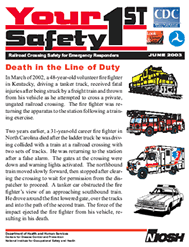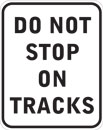| |
| |
This bulletin notes two firefighter fatalities that
involved fatal collisions between fire vehicles and oncoming trains
at railroad crossings. As practical steps for reducing risk, the bulletin
recommends that fire departments plan routes to avoid railroad crossings.
If crossings cannot be avoided, the bulletin recommends that fire
departments plan routes to include crossings with active warning devices,
such as flashing lights and gates, and with a clear line of sight
along the track in both directions. |
 |
|
 |
Death in the Line of Duty
In March of 2002, a 48-year-old volunteer fire fighter in Kentucky,
driving a tanker truck, received fatal injuries after being struck
by a freight train and thrown from his vehicle as he attempted to
cross a private, ungated railroad crossing. The fire fighter was
returning the apparatus to the station following a training exercise.
Two years earlier, a 31-year-old career fire fighter in North Carolina
died after the ladder truck he was driving collided with a train
at a railroad crossing with two sets of tracks. He was returning
to the station after a false alarm. The gates at the crossing were
down and warning lights activated. The northbound train moved slowly
forward, then stopped after clearing the crossing to wait for permission
from the dispatcher to proceed. A tanker car obstructed the fire
fighter’s view of an approaching southbound train. He drove
around the first lowered gate, over the tracks and into the path
of the second train. The force of the impact ejected the fire fighter
from his vehicle, resulting in his death. |
|
| |
| |
| |
| 
|
 This
document is also available in PDF format. This
document is also available in PDF format.
No. 2003-121pdf
4 pages, 726kb

|
|
 |
LOOK |
Plan your routes to avoid highway-rail grade crossings.
Otherwise, use crossings with active warnings and clear sightlines
down railroad tracks in both directions.
LOOK both ways before crossing. Trains can come from either direction.
Come to a complete stop at all crossings with passive warning devices
(no gates or flashing lights). Use caution and be prepared to STOP
at all crossings with active warning devices (flashing lights, gates).
Per National Fire Protection Association (NFPA) Standard 1500
Sec. 4-2.8.
When stopped, be sure your front or rear bumper clears the nearest
track by at least 15 feet. |
LISTEN
|
Before crossing, roll down windows, turn off siren
and radio, and listen for train horn. |
LIVE |
Always ….heed flashing lights, closing gates
and stop signs. 
Wait……...until safely through
the crossing before shifting gears or passing.
Never ……back up or stop on tracks. If gate
comes down on the vehicle,
keep going through the crossing.
|
|
|
| Most railroad crossings have information that identifies
their location, the railroad that uses that track, and an emergency
800 contact number. This information needs to be used when: |
- Your vehicle is caught on the crossing and/or in some way
blocks the track or
- The incident you are responding to involves a vehicle or pedestrian
on or near a crossing
|
|

|
Locate the U.S. DOT Inventory Crossing Number (six numbers
and a letter) that identifies your location, and the toll-free emergency
contact number. These numbers are usually found on the crossbuck post
or the post where the crossing gates are secured. Call the phone number
provided and report your emergency. |
| |
|
 |
SIGNS & WARNING DEVICES
|
| |
| |
ADVANCE WARNING SIGN
- Posted on side of road to denote railroad tracks ahead.
|
|
|
PAVEMENT MARKING
- Denotes railroad crossing ahead.
|
|
|
CROSSBUCK
- Fire fighter apparatus must come to a complete stop per
NFPA standards.
|
|
|
HUMPED – HIGH PROFILE CROSSING
- Low clearance vehicles should not attempt to cross. You
may get hung up on tracks.
|
|
|
CROSSBUCK and FLASHING LIGHTS
- A train is coming—DO NOT cross!
|
|
CROSSBUCK, LOWERED GATES and FLASHING LIGHTS
- A train is coming—DO NOT drive around the gates!
|
|
 |
| NIOSH, the National
Institute for Occupational Safety and Health, the Federal Railroad
Administration, and Operation Lifesaver, Inc. remind you to
be pro-active—your safety
first so you can get to the call |
IF A TRAIN COMES
|
| If your vehicle becomes hung up or stalls on the
crossing, get everyone out and keep a safe distance from the
tracks. If time permits before exiting, turn on the vehicle’s
emergency lighting system (strobe light, flashers). If you hear
or see a train approaching, move everyone at the crossing away
from the tracks in the direction of the oncoming train.
When a locomotive strikes a vehicle, it pushes it forward. By
heading in the direction of the oncoming locomotive you’ll
be moving away from any debris resulting from the impact. |
FOR MORE INFORMATION:
|
| |
NIOSH |
| www.cdc.gov/niosh/firehome.html |
(800) 356-4674 |
Department of Transportation |
| Federal Railroad Administration [www.fra.dot.gov] |
(202) 493-6024 |
| Federal Highway Administration [www.fhwa.dot.gov] |
(202) 366-1153 |
| Federal Transit Administration [www.fta.dot.gov] |
(202) 366-4043 |
| National Highway Traffic Safety Administration
[www.nhtsa.dot.gov] |
(202) 366-9550 |
Operation Lifesaver, Inc. |
| [www.oli.org] |
(800) 537-6224 |
|
| |
DID YOU KNOW?
|
 |
 |
Department of Health & Human Services
Centers for Disease Control & Prevention
National Institute for Occupational Safety & Health
4676 Columbia Parkway
Cincinnati, OH 45226-1998 |
|
Delivering on the Nation’s Promise: |
| Safety and health
at work for all
people through research and
prevention |
PROTECT YOUR EMERGENCY RESPONDERS!
|
|

